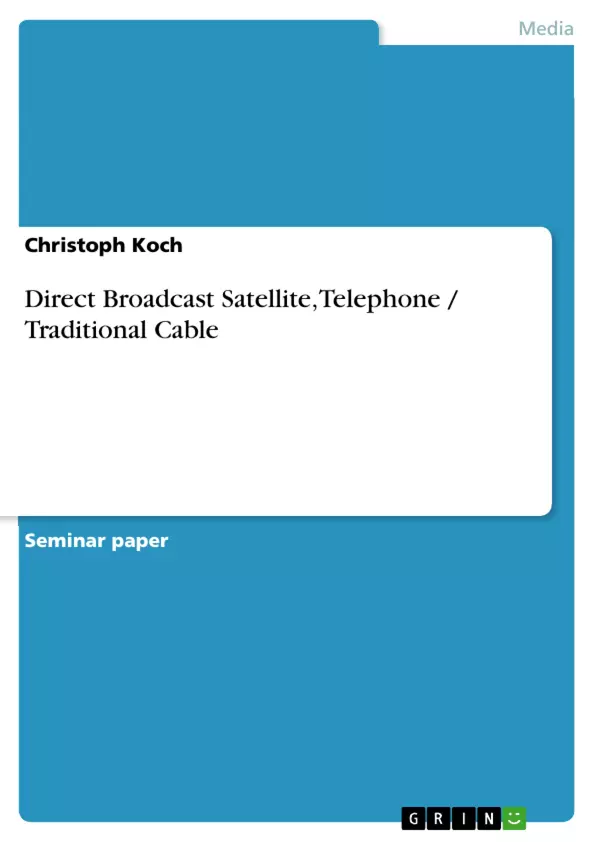It was only a very small report on the front page of last Thursday’s issue of USA Today, but it indicated a tremendous change not only for America’s telecommunications market, but also for its society as a whole. In a small box between headlines about the crisis in Kosovo the interested reader could find out that AT&T had announced to purchase cable giant MediaOne and that software producer Microsoft was about to invest $5 billion in AT&T shares. This huge move won’t let the video distribution market unchanged and many experts believe that this merger has triggered a lot of new developments in all kinds of fields.
This paper deals with the competition between traditional wired cable (as we know it since the beginnings of television) on the one hand – and newer services like direct broadcast satellites (DBS) and video and data distribution via telephone lines. While the first part will mainly cover the latest developments in the telephony business (focusing on the breathtaking AT&T deal), the second part will compare the benefits of cable and DBS in detail.
It lies in the nature of the subject that the playing field can change in a couple of weeks (if not even in a couple of hours). Therefor it is very important to rely on up-to-date information and literature. Especially literature from before the 1996 Telecommunications Act, which allowed cross-ownership between cable and telephony and the like, can’t be considered too useful and was used only to get a historic idea of the subject matter. In doing research in this field one also has to be especially careful not to rely on sources that are heavily influenced by either the cable or the DBS lobby. Both groups naturally try to present the facts in a light that makes them look better and emphasizes the advantages of their particular system over the ones of the competition.
Inhaltsverzeichnis (Table of Contents)
- INTRODUCTION
- AN ALLIANCE OF TITANS – THE AT&T DEAL
- COMPARISON CABLE VS. DBS
- Costs to the consumer
- User-friendliness
- Customer service
- Picture quality and reliability
Zielsetzung und Themenschwerpunkte (Objectives and Key Themes)
This paper examines the evolving landscape of video distribution in the United States, focusing on the competition between traditional cable, direct broadcast satellite (DBS), and video/data distribution via telephone lines. It explores the significant impact of the AT&T deal, which has led to a dramatic shift in the telecommunications market and the consolidation of industry players.
- The impact of the AT&T deal on the telecommunications market and its implications for competition.
- A comparative analysis of cable and DBS services, including costs, user-friendliness, customer service, and picture quality.
- The role of technology and innovation in shaping the future of video distribution.
- The influence of regulatory frameworks, such as the 1996 Telecommunications Act, on market dynamics.
- The challenges and opportunities presented by the convergence of cable, telephone, and internet technologies.
Zusammenfassung der Kapitel (Chapter Summaries)
The introductory chapter provides an overview of the telecommunications market, highlighting the major trends and developments, including the AT&T deal. The paper then delves into the competition between cable and DBS services, exploring various aspects such as costs, user-friendliness, and customer service. It examines the impact of factors like technology, regulatory frameworks, and market consolidation on the video distribution landscape.
The second part of the paper delves into a detailed comparison of cable and DBS services, focusing on key areas like costs, user-friendliness, customer service, and picture quality. It provides insights into the strengths and weaknesses of each technology and discusses the advantages and disadvantages for consumers.
Schlüsselwörter (Keywords)
The paper focuses on key concepts such as cable television, direct broadcast satellite (DBS), telecommunications, AT&T, MediaOne, Comcast, Microsoft, video distribution, customer service, costs, user-friendliness, picture quality, regulation, and market consolidation. It delves into the impact of these factors on the evolving landscape of video distribution in the United States.
- Quote paper
- Christoph Koch (Author), 1999, Direct Broadcast Satellite, Telephone / Traditional Cable, Munich, GRIN Verlag, https://www.grin.com/document/3946



